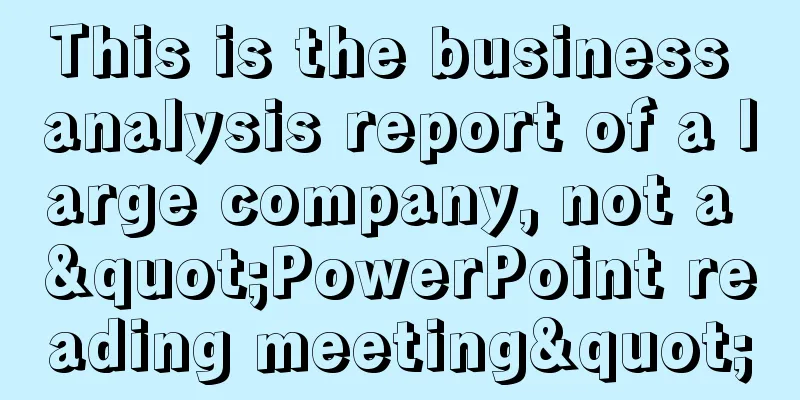This is the business analysis report of a large company, not a "PowerPoint reading meeting"

"Too long and unclear about the main points" is a common problem of business analysis reports. People who make reports often mechanically list various details such as sales and costs, and add year-on-year, month-on-month, time progress ratio, and KPI achievement ratio. Even after dozens of pages of PPT, the main points cannot be seen, let alone "supporting decision-making and driving business". If you want to improve efficiency and turn business analysis meetings into decision-making meetings instead of "routine meetings", "PowerPoint reading meetings" or "blame-shifting meetings", you need to pick out the key issues from the numerous data and help everyone focus on the core issues. Here are the five most critical issues. Key question 1: Macro environmentWhether there is a problem with the macro environment is the first thing to confirm clearly. If the macro environment really changes, it is impossible to cope with it with the strength of a single function, and the whole company needs to work together to find a solution; if the macro environment does not fluctuate greatly, then a single business function cannot use the "macro environment" as an excuse. Clarifying the macro environment first can effectively avoid "passing the buck" and focus on key issues. When judging the macro environment, the most taboo is to be "big and empty". It is not enough to just say "the macro environment is not good". What everyone wants to know is: which macro factors have specifically affected which aspects of our company. Specifically in the business process, what is relatively easy to quantify is:
Some factors work indirectly, such as competitor activities, epidemics, policies, etc. When judging the impact of these factors, you need to first clarify the logic of the impact, then list the supporting evidence, and then calculate the impact on specific businesses (as shown in the figure below). This forms a complete logical chain, which can not only confirm the impact of external factors, but also enable continuous monitoring. When the environment deteriorates further, an alarm can be further issued. Key Question 2: Overall ProgressOverall progress is the focus of all business analysis reports. However, conventional reports often list a lot of year-on-year and month-on-month changes without distinguishing right from wrong, which makes readers very tired. Progress reports follow the principle of "from big to small, from near to far", and explain step by step: At the same time, when reporting progress, the revenue/cost sides are often separated. Business reports always focus on revenue growth, while financial reports focus on cost details. This affects judgment. The best approach is to reconstruct cost data based on the "effects of different costs on revenue" and see in relation: what role each part of the cost plays (as shown in the figure below). After deconstruction, it is easier to see if there are any problems with the business progress. Common ones include:
If you do not deconstruct it according to its effect on revenue, and still classify it into "sales expenses" and "administrative expenses" according to financial classification, you will not be able to see the details. In many companies, the financial department does not understand the business, and the cost data is not communicated with the business, so it is difficult to deconstruct it according to business logic. This point should be paid special attention to. Key question three: business structureTo explain the whole problem, we need to go into the business details. A common mistake here is to cross-reference as many dimensions as there are. For example, if there are several dimensions such as products, customer groups, channels, and branches, each dimension is crossed with revenue and cost, forming a densely packed report with a bunch of indicators that are high or low, low or high... Of course, you can't see the reason. Note! There may be correlations between businesses. For example, it may seem that there are problems with customers, channels, and branches, but in fact, it may be that a certain product is not well done, resulting in changes in a series of data indicators. When analyzing the business structure, the focus is to find the core reasons in the business to avoid mindless out-of-table analysis. Key question 4: Detailed experienceMany times, after reading the operating report, people feel that they are still not satisfied, as if the report only talks about "XX indicator has fallen" but does not talk about opportunities. If you want to find opportunities, the best way is to stratify the business, distinguish the performance of each business unit, and find the benchmark. This will prompt everyone to think: "Can the benchmark approach be replicated?" "Where are the other gaps?" Note! Benchmarking does not mean ranking by sales volume, and the one with the highest sales volume is the benchmark. Comparability of similar products is the principle of benchmarking. For example, when comparing different products, we need to consider: product launch time, product price range, and product classification. Similar products with the same launch time are easier to compare. The comparison indicators are not limited to sales revenue, sales volume, cross-purchase rate, and inventory turnover. They can all be used as comparison indicators. The products that are distinguished in this way are not limited to those that sell a lot. Those that are niche but have high profits, good turnover, and good inventory control at the end of their life cycle can all become benchmarks. For example, when comparing different regions, the population, economic level (per capita disposable income), and development strength (number of stores/population) of the regions themselves are different. We should first classify the regions, distinguishing between 1st, 2nd, and 3rd-tier markets, and then classify the development investment, distinguishing between key and non-key areas, and then classify the stores, distinguishing between flagship, ordinary, and mini. In the same-level market, find benchmark stores of the same level, so that it is easier for everyone to accept. Key Question 5: Development TrendsFinally, there is the future outlook, which is a point that many traditional business analysis reports will ignore. If this part is missing, people will feel that it is not enough, as if a lot of things that everyone knows are said. But when it comes to predicting development trends, many students feel guilty, "Do we need to make a prediction?" "What model can accurately predict?" Various questions frequently arise. Attention! Forecasting in business analysis is completely different from forecasting for user operations and product recommendations. Forecasting in business analysis considers more the natural development trend + the impact of business actions. How will the natural trend go, to what extent can the business actively influence it, and whether there are any extra attentions are the key. Therefore, when making future predictions, we need to consider the conclusions of the previous four questions and make a comprehensive judgment based on the natural cycle. 1. According to the natural cycle, the trend in the next few months is... 2. The current problem is... The expected impact is... 3. The follow-up work plan for the business is... The estimated time to solve the problem is... As shown below This not only reminds us of the seriousness of the problem, but also encourages leaders to form resolutions at the business analysis meeting and promotes the business to solve the problem. After each business analysis report, 3 to 5 follow-up issues can be identified through the business meeting, and then supervised and implemented. The follow-up results are reported at the next business meeting. This is the best state (finally not "reading PPT meeting"). summaryNote! For these five key questions, follow the principle of "if there is a problem, give a hint; if there is no problem, don't bother". If there is no problem, there is no need to elaborate on it. Just focus on the key points based on the situation this month/quarter. Therefore, at the beginning of the entire report, a concise summary is needed to clearly state the main data and issues. If the leaders present have questions, then expand on the details. If there are no questions, go straight to the key issues. This can greatly enhance the reader's experience and avoid the problem of the "foot-binding cloth" report mentioned at the beginning. |
<<: A private domain operator tells you how to double user retention (Part 2)
>>: If the boss doesn’t use TikTok, the company will be finished!
Recommend
Can Amazon Video Certification be used as an alternative? How to prepare?
In Amazon, people usually go for video authenticat...
Self-cultivation of Internet celebrity cities
Shandong Zibo, which has become popular on the Int...
Is the salary of a logistics manager at AliExpress good? Job responsibilities of a logistics manager
With the rapid development of cross-border e-comme...
8000 words of practical information | How to formulate a profitable and sustainable "pricing system" when playing membership?
Nowadays, membership has become the mainstay busin...
What are the essential steps for Amazon beginners?
Amazon is the first stop for most people who trave...
Will the price increase of Shopee affect traffic? How to maintain traffic?
When opening a store on Shopee, the price of the p...
Research Report | The Evolution of Social Media Marketing in the AI Era by 2024
In the AI era, social media marketing is undergo...
Diamond Marketing Psychology: How Three Slogans Create Diamond Miracles?
Starting from the history of diamond marketing, th...
Does Amazon Europe need VAT for self-delivery? Under what circumstances do I need to register for VAT?
If you want to open a store on Amazon Europe, you ...
How to find merchants for Amazon reviews? What is the method?
There are many ways for sellers to find buyers, an...
The "disappeared" anchors return before Double 11
In fact, the return of big anchors is the result o...
What does Amazon off-site traffic generation mean? How to generate traffic?
Amazon stores cannot develop without traffic, and ...
What is Shopee? What are the conditions and fees for joining Shopee?
Friends who do cross-border e-commerce should all ...
Five new “authentic flavors”! How does Lay’s decode local culture?
This article delves into how Lay's decodes Chi...
2023, not only private domain, but also growth!
Different user groups have different strategies fo...









